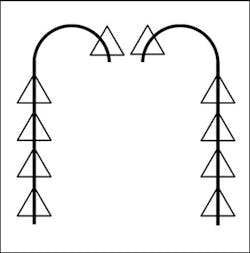The flag captain, finally acting on his own initiative in his bid to save the ship Victoria, ordered full astern on both propellers but it was already too late.
June 23, 1893, was another clear and dazzling day in the Mediterranean. The British naval squadron was on summer maneuvers, traversing the coast, showing the flag in Egypt, Malta and various other ports. The eight battleships and three large cruisers had been in Beirut, Lebanon for five days and weighed anchor in the morning enroute to their next port of call, Tripoli.
Great Britain may have been a nation at peace but they ruled their vast dominions with a navy designed to project a sense of over-whelming power and invincibility. The Mediterranean, confluence of the Strait of Gibraltar, the Suez Canal and the Dardanelles was in many respects, the strategic center of the universe for the empire. The command of the Mediterranean fleet was one of the most prestigious and important in the Royal Navy. It was reserved for senior leaders who had clearly demonstrated their ability to make decisions and to maintain a high state of readiness.
The fleet was commanded by Vice Admiral Sir George Tryon, a brilliant and dynamic officer and outstanding seaman. He was considered by many to be the best of the best but could also be overbearing and an iron disciplinarian. And, to make matters more complicated, he was virtually always correct. It was said by his fellow officers that he never took a false step until June 23.
Clear Communication
Tryon was known for his unorthodox approach to one of the most perplexing challenges posed by combat operations, including firefighting: communications. At the end of the 19th century, in the era before radio and radar, the fleet communicated by raising (and lowering) a series of flags which, because they were meant to be read in combination with one another, could have thousands of different meanings related to changes in course, speed and other tactical maneuvers. A signal raised by the flagship was to be answered quickly and precisely by others in the squadron before proceeding. The analogy would be a fireground commander issuing an initial coded radio command that would have to be affirmatively answered by every intended recipient which would then result in the commander giving the actual command to execute the order.
Tryon found this system to be cumbersome, slow and ineffective, as indeed it was, especially when it was needed most, as the fleet was maneuvering in battle. He proposed, and then implemented a radical departure from the centuries old flag system and he called it "TA". When Tryon raised a single flag indicating that TA was in effect, ships in his fleet were to follow the flagship's (or other designated leader's) movements without waiting for or acknowledging further signals, until otherwise advised. Now, similar to fireground standard operating procedures, the naval officers were empowered to take actions consistent with the intention of the fleet commander.
Tryon's way of practicing this system and to keep the fleet on its toes when they were on routine exercises was to constantly, and without warning, engage in complex maneuvers while providing minimum guidance beforehand. In fact, while his TA system was in effect he would also continue to issue a series of complicated orders via the traditional flag system. He expected his fleet officers to obey these signals immediately and without question.
An analogy might be a fireground commander who simultaneously encourages a degree of flexibility during an incident while also expecting companies to adhere closely to operating procedures even as he or she is not averse to ordering actions that deviate from those very procedures. If the incident commander is a strong leader with an impressive track record it is a recipe for confusion and (possibly) disaster. Tryon was the strongest of leaders and his officers deferred to his leadership. He had effectively created a situation where he was unlikely to get critical feedback when it mattered the most.
Six Cables
As they approached the port of Tripoli, Admiral Tryon, on board the Victoria, his flagship, called his staff commander, flag captain and flag lieutenant to his cabin. Consistent with his practice of issuing orders for complicated maneuvers, he told them to "form the fleet into columns of divisions, six cables apart, and reverse the course by turning inwards." This would place the fleet in two columns, abreast of one another, sailing in a straight line and twelve hundred yards apart since each cable was equal to 200 yards. On his signal, the columns would turn inward toward each other and reverse their course by 180 degrees so that they would then be traveling in the opposite direction, still in two columns.
All three highly experienced officers had the same immediate reaction: twelve hundred yards was not enough room to turn these massive ships towards one another in a 180 degree turn. The staff commander suggested eight cables to the admiral who appeared to agree. But a short while later when he was asked to confirm that eight cables was correct, he firmly stated that he said six cables and it would stay at six. He even wrote the number "6" on a piece of paper and passed it to one of the officers. "Tryon was not a person who was agreeable on being asked questions or cross examined."
In the following minutes the initial flags were raised and the fleet divided into the two lines abreast with the Victoria in the lead in one column and the Camperdown in the lead in the column to port, a little over a half-mile away. Following the Victoria at a speed of eight knots and separated by four hundred yards were the Nile, Dreadnought, Inflexible, Collingwood, and Phaeton. The minimum combined turning circles of the lead ships, the Victoria and the Camperdown was eight cables or sixteen hundred yards.
Collision
The Admiral gave the order to begin the turn as the coastline approached and the lead ships in both columns commenced a hard turn, the Victoria to port and the Camperdown to starboard. The flag captain of the Victoria, convinced of the impending disaster and faced with at least two options, questioning Tryon or ordering immediate evasive action, chose the former, once again warning the Admiral of the need to act. He was ignored. The two ships were closing at almost 18 knots.
The ships had been in their turns for two minutes. Over the next 30 seconds, rather than take action on his own, the flag captain asked the Admiral three more times for permission to either reverse his helm or to go astern with the port screw to counteract the turn. The Admiral eventually said, "Yes, go astern." The flag captain, finally acting on his own initiative in his bid to save the ship, ordered full astern on both propellers but it was already too late.
The Camperdown was turning on a wider arc than the Victoria and as a result struck her near the bow at almost a right angle with a hardened steel ram designed to sink ships. The combined impact speed was about 11 knots. The Camperdown tore nine feet into the bow of the Victoria with the impact force of a blank 13.5-inch shell fired at close range. The results were devastating. Almost immediately, and too late to make any difference, the Camperdown went full astern on both props and slowly pulled away from the Victoria, allowing tons of water to pour into the stricken ship through the gaping hole.
Now in the rough equivalent of a "Mayday" situation, other ships in the fleet began to lower lifeboats to aid the stricken Victoria. Inexplicably, Admiral Tryon, always averse to having his orders questioned, much less countermanded, cancelled the order and attempted to steer the ship towards the coast, some four miles away.
A little more than nine minutes after the collision on a cloudless afternoon in perfectly calm seas, the Victoria, pride of the Mediterranean fleet, heeled over to starboard and sank explosively, taking 358 crew members with her.
Nearly Blind Obedience
A few weeks later a court martial was convened on the Island of Malta to try the captain of the Victoria and her men to determine their culpability in the accident. It quickly became clear that Admiral Tryon had admitted it was "all his fault" in the minutes after the collision occurred. The good admiral (admirably) went down with his ship but the court was not fully satisfied. They also singled out the captain of the Camperdown and Vice Admiral Markham, second in command of the Mediterranean fleet, and also aboard the Camperdown, for their willingness to obey and execute an order they almost certainly knew was likely to cause a catastrophe, as indeed it did.
The Victoria-Camperdown incident is legendary in naval history as a stunning example of what can occur when officers fail to act aggressively in situations where they know that pursuing a particular course will likely result in serious and unnecessary danger to operating forces. It also definitely proves that the most brilliant incident commander is capable of making fatal blunders and that clear communication, even when it includes a strong dissent from junior officers, is the only way to protect troops.
The Victoria incident also underscores that blindly and mechanically completing maneuvers in a rote fashion sets up a dynamic where risk will not be evaluated, at least in real time. In the profession of firefighting, this is particularly true in the area of conducting occupant searches in buildings where there is a very low likelihood of either locating anyone or locating anyone alive and the automatic deployment of a hoseline into a clearly marginal area where, again, the only life safety challenge is to the firefighters themselves. If we took the time to add up all the firefighter fatalities directly attributable to blind obedience and the completion of rote tasks, the Victoria's 358 lost would be a bargain. We need to change that.
Questions For A Training Discussion:
- What kept the other officers from speaking up?
- What level of risk is appropriate for a training exercise?
- How can an incident commander ensure that they are receiving critical information and feedback?
- What are some ways to ensure that risk is evaluated in real time?
ERIC LAMAR lives and works in Washington, D.C. He has been involved in the fire service for 30 years. To read Eric's complete biography and view his archived articles, click here. You can reach Eric by e-mail at [email protected]..

Eric Lamar | For Firehouse.com
Eric Lamar lives and works in Washington, D.C. He has been involved in the fire service for 30 years.






